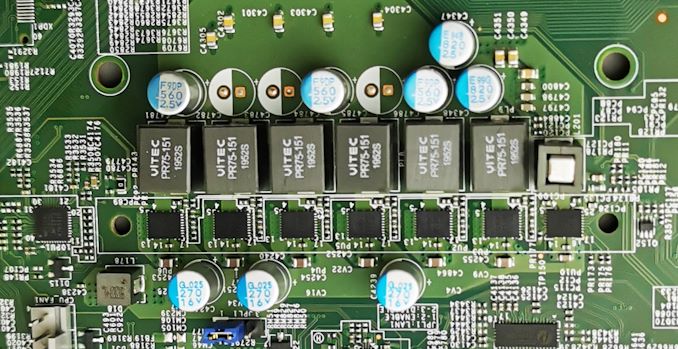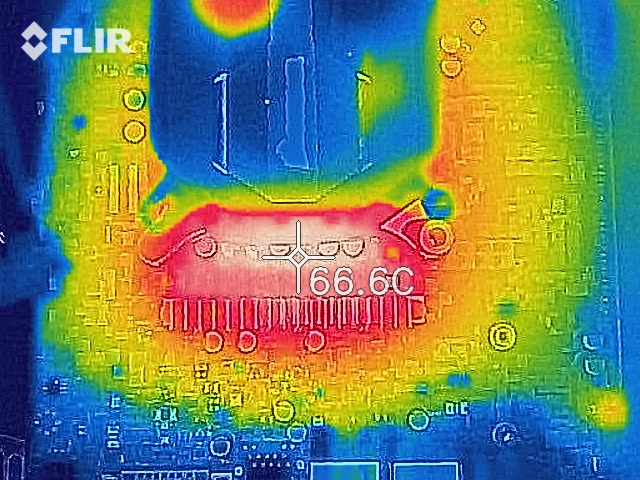Supermicro X12SAE W480 Motherboard Review: For Xeon W-1200 Workstations
by Gavin Bonshor on December 11, 2020 9:30 AM ESTPower Delivery Thermal Analysis
A lot more focus has been put onto power delivery specifications and capabilities, not just by manufacturers, but as a result of users demands. In addition to the extra power benefits from things like overclocking, more efficient designs in power deliveries and cooling solutions aim to bring temperatures down. Although this isn't something most users ever need to worry about, certain enthusiasts are bringing more focus onto each board's power delivery. The more premium models tend to include bigger and higher-grade power deliveries, with bigger and more intricate heatsink designs, with some even providing water blocks.
Testing Methodology
Our method of testing out if the power delivery and its heatsink are effective at dissipating heat, is by running an intensely heavy CPU workload for a prolonged method of time. We apply an overclock which is deemed safe and at the maximum that the silicon on our testbed processor allows. We then run the Prime95 with AVX2 enabled under a torture test for an hour at the maximum stable overclock we can which puts insane pressure on the processor. We collect our data via three different methods which include the following:
- Taking a thermal image from a birds-eye view after an hour with a Flir Pro thermal imaging camera
- Securing two probes on to the rear of the PCB, right underneath CPU VCore section of the power delivery for better parity in case a probe reports a faulty reading
- Taking a reading of the VRM temperature from the sensor reading within the HWInfo monitoring application
The reason for using three different methods is that some sensors can read inaccurate temperatures, which can give very erratic results for users looking to gauge whether an overclock is too much pressure for the power delivery handle. With using a probe on the rear, it can also show the efficiency of the power stages and heatsinks as a wide margin between the probe and sensor temperature can show that the heatsink is dissipating heat and that the design is working, or that the internal sensor is massively wrong. To ensure our probe was accurate before testing, I binned 10 and selected the most accurate (within 1c of the actual temperature) for better parity in our testing.
To recreate a real-world testing scenario, the system is built into a conventional desktop chassis which is widely available. This is to show and alleviate issues when testing on open testbeds which we have done previously, which allows natural airflow to flow over the power delivery heatsinks. It provides a better comparison for the end-user and allows us to mitigate issues where heatsinks have been designed with airflow in mind, and those that have not. The idea of a heatsink is to allow effective dissipation of heat and not act as an insulator, with much more focus from consumers over the last couple of years on power delivery componentry and performance than in previous years.
For thermal images, we use a Flir One camera as it gives a good indication of where the heat is generated around the socket area, as some designs use different configurations and an evenly spread power delivery with good components will usually generate less heat. Manufacturers who use inefficient heatsinks and cheap out on power delivery components should run hotter than those who have invested. Of course, a $700 flagship motherboard is likely to outperform a cheaper $100 model under the same testing conditions, but it is still worth testing to see which vendors are doing things correctly.

The 6+1 power delivery on the Supermicro X12SAE
The Supermicro X12SAE is using a 7-phase design which is operating in a 6+1 configuration. It is using six Monolithic Power Systems MPSJ10 MOSFETs for the CPU VCore, and one MPSJ10 for the SoC. Controlling this power delivery is an MPS2975, which looks to be a new part and the official specifications are not currently available. It is likely to be a newer version of the MPS2965 which is a dual output controller with seven phases supported in total. Cooling the power delivery is a thin aluminum heatsink which is connected via plastic push through clasps.
Thermal Analysis Results
When it comes to power deliveries on models such as this one, they are generally built to specification for the purpose they serve. While not fanciful and overcompensating for extra voltage, they do the job. Motherboards designed for mass systems like the W480 green-PCB models tend to filter in one of two ways - incredibly good server-class power delivery (which Supermicro often says is due to its deep experience within the server world), or built down to a price in order to meet those market demands. Either way, these boards are often built with a specific chassis (or 1U server) with the airflow characteristics in mind, and the power delivery is often built to reflect that design.

We measured 66.6°C on the hottest part of the PCB which was around the CPU socket
The way in which we test boards such as the Supermicro X12SAE differs from how we test conventional desktop models. Firstly, the W480 chipset doesn't include support for overclocking, so we're limited to the default settings. Secondly. motherboards like this generally focus on building elements to specification so that they work out of the box. This means the "INSERT" power delivery on the X12SAE can handle and deliver the performance expected from the top tier CPU that it officially supports.
After running Prime95 with the smallest FFTs with AVX loads enabled which is designed to put plenty of stress on our W-1270, we got a reading of 71°C from our K-type thermocouple. We observed a maximum temperature of 66.6°C from our FLIR thermal imaging camera, and as is seen from the above image, the heat is distributed around the CPU and power delivery area quite evenly. The bulk of the heat is emanating from the power delivery area, which is cooled by a slim aluminum finned heatsink. Compared to consumer class heatsinks, this seems woefully inadequate, however Supermicro has used some efficient power delivery components here, and the heatsink is built with a specific airflow in mind.
Possible CPU Sensor Issue
When fully loading our Intel Xeon W-1270 processor, increasing temperatures as the load was increased, we saw that we would enable Supermicro's integrated sensor to beep, as a warning. Upon loading up HWiNFO and retesting, we noticed that the CPU temperature reading within HWiNFO would occasionally be inconsistent, and would sometimes not even register a temperature reading. At other times it would underestimate the temperature moving it into sub-zero temperature with a reading of -66°C. This would cause the system to beep, as the sensor was out of range.
We're unsure if this is down to the monitoring tools, or a specific faulty/temperamental sensor on this specific model. The X12SAE performed well under our thermal testing and none of the performance benchmarks seem affected. We ensured we had the latest BIOS, and even implemented extra cooling to the CPU and socket area, but the problem was still occasionally there. (Note, Ian tested the board in his office the week prior and didn't see this issue in his automated testing, so we're pretty sure this might just be a semi-failed sensor.)










55 Comments
View All Comments
MFC - Friday, December 11, 2020 - link
Check the 2nd line in the Monolithic Power Systems Mosfet. The top line is the date code, the 2nd line is the part number. 3rd line is the lot number.tpurves - Friday, December 11, 2020 - link
I... don't understand how AMD does not seem to exist in the universe where you are testing this board? Hasn't AMD pretty much made any Intel-based workstation/HEDT build pointless at this point? or what am I missing here that you would want to consider building a Xeon workstation for in 2021? I can't tell because the word 'AMD' is not even mentioned in the entire review.DannyH246 - Friday, December 11, 2020 - link
Classic behaviour from www.IntelTech.com.No review of the new AMD GPU's to be seen. And no mention of AMD in this review. (i.e how this board is effectively a waste of money, as who would want to by Intel at the moment)
Operandi - Friday, December 11, 2020 - link
Point being why even review this in the context of a world where the platform AMD exists? From a feature and performance stance AMD is better on both. Unless there is something Supermicro has that other board vendors don't as I don't think Supermicro has a "workstation" AM4 board but still, so what...christinescoms - Saturday, December 12, 2020 - link
hellochristinescoms - Saturday, December 12, 2020 - link
I get paid more than 120 to 130 per hour for working online. I heard about this job 3 months ago and after joining this i have earned easily 15k from this without having online working skills. This is what I do.....___christinescoms - Saturday, December 12, 2020 - link
I get paid more than 120 to 130 per hour for working online. I heard about this job 3 months ago and after joining this i have earned easily 15k from this without having online working skills. This is what I do.....___christinescoms - Saturday, December 12, 2020 - link
I get paid more than 120 to 130 per hour for working online. I heard about this job 3 months ago and after joining this i have earned easily 15k from this without having online working skills. This is what I do.....___bit.ly/googlework75Deicidium369 - Friday, December 11, 2020 - link
Yeah how shortsighted to not include AMD in a review of an Intel motherboard - this is pure fanboyism on Anandtech's part.../s
Oxford Guy - Friday, December 11, 2020 - link
People are quick to claim maliciousness but sometimes oversights and oversights.It is an oversight to not present a product in its context. The context does include the competition.